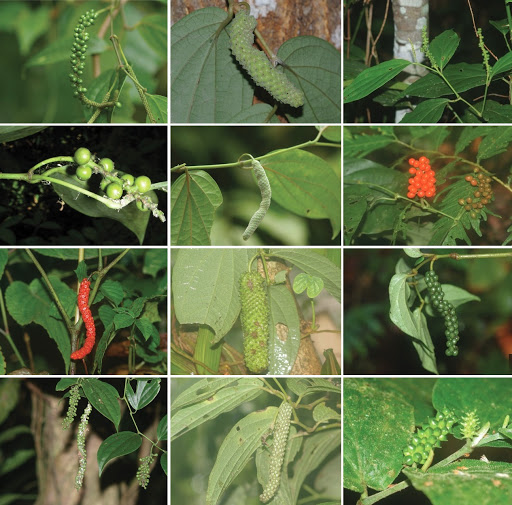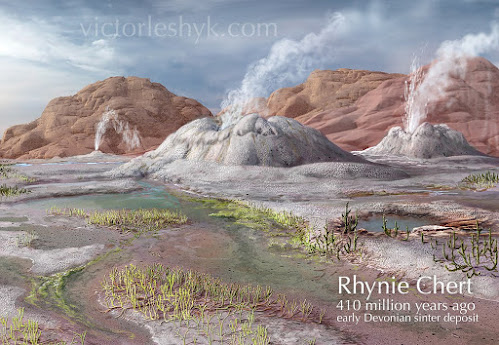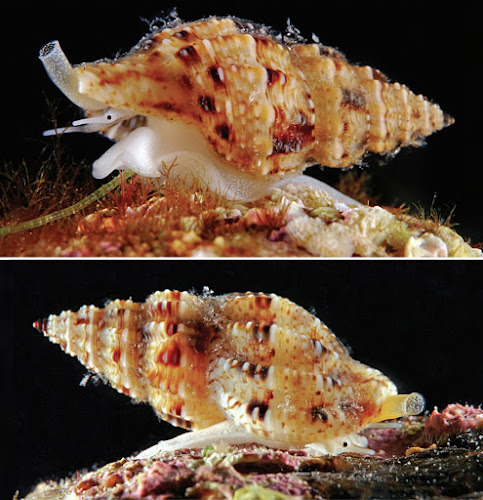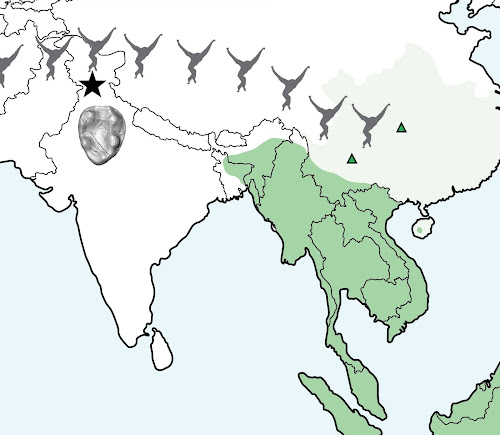[Most Recent Entries] [Calendar View]
Friday, September 11th, 2020
| Time | Event | ||||||
| 8:49a | [Botany • 2020] A Synopsis of Thai Piper (Piperaceae)
ABSTRACT All native and introduced Thai Piper are enumerated to include 46 species and two varieties. Typifications for accepted names and synonyms are made where necessary. Family and generic descriptions, based on Thai collections, are provided. A key to species and varieties and relevant synonymy are also presented. Additional morphological characters for P. smitinandianum are summarised. Data on the distribution, ecology, vernacular names, utilization and collections of each taxon in Thailand are presented in the standard Flora of Thailand format. Keywords: Distribution, Flora of Thailand, key to species, tropical plant, taxonomy Chalermpol Suwanphakdee, David A. Simpson, Trevor R. Hodkinson and Pranom Chantaranothai. 2020. A Synopsis of Thai Piper (Piperaceae). Thai Forest Bulletin (Botany). 48(2), 145-183. DOI: 10.20531/tfb.2020.48.2.08 | ||||||
| 10:09a | [Paleontology • 2020] Genomic and Fossil windows into the Secret Lives of the Most Ancient Fungi Abstract Fungi have crucial roles in modern ecosystems as decomposers and pathogens, and they engage in various mutualistic associations with other organisms, especially plants. They have a lengthy geological history, and there is an emerging understanding of their impact on the evolution of Earth systems on a large scale. In this Review, we focus on the roles of fungi in the establishment and early evolution of land and freshwater ecosystems. Today, questions of evolution over deep time are informed by discoveries of new fossils and evolutionary analysis of new genomes. Inferences can be drawn from evolutionary analysis by comparing the genes and genomes of fungi with the biochemistry and development of their plant and algal hosts. We then contrast this emerging picture against evidence from the fossil record to develop a new, integrated perspective on the origin and early evolution of fungi. Environmental microbiology, Fungal ecology, Fungal evolution, Fungal genomics Mary L. Berbee, Christine Strullu-Derrien, Pierre-Marc Delaux, Paul K. Strother, Paul Kenrick, Marc-André Selosse and John W. Taylor. 2020. Genomic and Fossil windows into the Secret Lives of the Most Ancient Fungi. Nature Reviews Microbiology. DOI: 10.1038/s41579-020-0426-8 | ||||||
| 10:27a | [Mollusca • 2020] The Genus Leufroyia Monterosato, 1884 [Revision of Mediterranean and NE Atlantic Raphitomidae (Gastropoda, Conoidea) 8]
Abstract The four recent species of the genus Leufroyia Monterosato, 1884 are revised based on an integrative taxonomy approach: L. leufroyi (Michaud, 1828), L. concinna (Scacchi, 1836), L. erronea Monterosato, 1884 and L. villaria (Pusateri & Giannuzzi-Savelli, 2008).
Family RAPHITOMIDAE Bellardi, 1875 Genus Leufroyia Monterosato, 1884 TYPE SPECIES. — Pleurotoma leufroyi Michaud, 1828, by subsequent designation (Crosse 1885). DISTRIBUTION. — Stratigraphic distribution: the genus appears in the Middle Miocene with records from the Langhian of the Loire Basin (France) (Peyrot 1938; Glibert 1954). Th en it is known from the Langhian-Serravallian of the Paratethys, with records from the Vienna Basin, Austria (Hörnes 1854), Poland (Bałuk 2003), Ukraine (Friedberg 1912), the Karaman Basin (Serravallian Proto-Mediterranean), Turkey (Landau et al. 2003). In the Late Miocene it has been revised in the Tortonian of the nothwestern France (Landau et al. 2020), and it is known from the Messinian of the Loire Basin (France) (Brébion 1964). Th en, it is continuously present throughout the Pliocene (e.g. Sacco 1904; Cipolla 1914), and the Pleistocene (e.g. Cerulli-Irelli 1910). Based on the current knowledge, the extant species of the genus are restricted to the North-East Atlantic, from the North Sea (Norway) south to Angola, and the Mediterranean Sea. Leufroyia leufroyi (Michaud, 1828) Leufroyia concinna (Scacchi, 1836) Leufroyia erronea Monterosato, 1884 Leufroya villaria (Pusateri & Giannuzzi-Savelli, 2008) Riccardo Giannuzzi-Savelli, Francesco Pusateri, Jakov Prkić, Stefano Bartolini, Valeria Russini, Giulia Fassio and Marco Oliverio. 2020. Revision of Mediterranean and NE Atlantic Raphitomidae (Gastropoda, Conoidea) 8: The Genus Leufroyia Monterosato, 1884. Zoosystema. 42(22); 433-473. DOI: 10.5252/zoosystema2020v42a22 | ||||||
| 10:39a | [PaleoMammalogy • 2020] Kapi ramnagarensis • New Middle Miocene Ape (Primates: Hylobatidae) from Ramnagar, India fills Major Gaps in the Hominoid Fossil Record
Abstract The fossil record of ‘lesser apes’ (i.e. hylobatids = gibbons and siamangs) is virtually non-existent before the latest Miocene of East Asia. However, molecular data strongly and consistently suggest that hylobatids should be present by approximately 20 Ma; thus, there are large temporal, geographical, and morphological gaps between early fossil apes in Africa and the earliest fossil hylobatids in China. Here, we describe a new approximately 12.5–13.8 Ma fossil ape from the Lower Siwaliks of Ramnagar, India, that fills in these long-standing gaps with implications for hylobatid origins. This ape represents the first new hominoid species discovered at Ramnagar in nearly a century, the first new Siwalik ape taxon in more than 30 years, and likely extends the hylobatid fossil record by approximately 5 Myr, providing a minimum age for hylobatid dispersal coeval to that of great apes. The presence of crown hylobatid molar features in the new species indicates an adaptive shift to a more frugivorous diet during the Middle Miocene, consistent with other proposed adaptations to frugivory (e.g. uricase gene silencing) during this time period as well. Keywords: Asia, fossil, lower Siwaliks, gibbon, biogeography, hylobatid  Systematic palaeontology Order Primates Linnaeus, 1758 Suborder Anthropoidea Mivart, 1864 Infraorder Catarrhini Geoffroy St. Hilaire, 1812 Superfamily Hominoidea Gray, 1825 Family Hylobatidae Gray, 1870 Kapi ramnagarensis gen. et sp. nov. Etymology: Genus name from the Hindi word for a common anthropoid ape or monkey (kapi). Species name in reference to Ramnagar (Jammu and Kashmir), India, where the type specimen was found. Horizon: Lower Siwalik deposits; approximately 12.5–13.8 Ma Christopher C. Gilbert, Alejandra Ortiz, Kelsey D. Pugh, Christopher J. Campisano, Biren A. Patel, Ningthoujam Premjit Singh, John G. Fleagle and Rajeev Patnaik. 2020. New Middle Miocene Ape (Primates: Hylobatidae) from Ramnagar, India fills Major Gaps in the Hominoid Fossil Record. Proceedings of the Royal Society B: Biological Sciences. 287(1934), 20201655. DOI: 10.1098/rspb.2020.1655 | ||||||
| 11:08a | [Herpetology • 2020] Fifty years After: A Taxonomic Revision of the Amphibian Species from the Ecuadorian Biodiversity Hotspot Abra de Zamora, with Description of Two New Pristimantis Species
Abstract
Pristimantis samaniegoi sp. nov. Székely, Eguiguren, Ordóñez-Delgado, Armijos-Ojeda, and Székely Common English name. Samaniego’s Rain Frog Common Spanish name. Cutín de Samaniego Etymology. The specific epithet is a noun in the genitive case and is a patronym for Dr. Gustavo Samaniego Rodríguez. The name is given as a tribute to his important contribution to the conservation of biodiversity in southern Ecuador. Through a generous donation of an important part of his estate, he contributed to the creation of the administrative and interpretation center in the Cajanuma sector of the Parque Nacional Podocarpus, which is one of the most important Ecuadorian sites of endemism and biodiversity. He was a university professor for over 40 years, and currently still maintains the "Reserva El Cristal" agro-ecological farm as an example of sustainable land management. Distribution. Pristimantis samaniegoi is known only from the Cajanuma entrance to the Parque Nacional Podocarpus and about 13 km in the north, in Abra de Zamora (Fig 6). We did not encounter this species in any similar habitats located in the vicinity of the type locality, despite fieldwork being carried out regularly since 2016. The species was encountered at an altitudinal range between 2560 and 3300 m a.s.l., in evergreen upper montane forest (Fig 2C), subpáramo (Fig 2B) and shrub páramo ecosystems.
Pristimantis matildae sp. nov. Székely, Eguiguren, Ordóñez-Delgado, Armijos-Ojeda, and Székely Common English name. Matilde’s Rain Frog Common Spanish name. Cutín de Matilde Etymology. The specific epithet is a noun in the genitive case and is a patronym for Matilde Hidalgo Navarro (1889–1974). She was the first woman to obtain a medical degree in the country, and the first woman in Ecuador (and Latin America) to exercise the right to vote in a national election. A tireless fighter for women’s rights, she laid important foundations for the development of women in academia and science, nationally and in South America. In Ecuador, there are currently many women involved in biological sciences and with this species, in addition to being a tribute to Matilde, we honor their tireless work for the conservation of biological diversity. Distribution. Pristimantis matildae is known only from Abra de Zamora and the Cajanuma sector from the Parque Nacional Podocarpus, about 13 km to the south (Fig 6). We were not able to encounter this species in adjacent areas, with similar ecosystems. However, about 35 km south from the type locality, we found another bromeliad specialist from the P. colodactylus subgroup, a genetically and morphologically similar, undescribed species. Pristimantis matildae was encountered at an altitudinal range between 2800 and 3360 m a.s.l. in subpáramo (Fig 2B) and shrub páramo ecosystems. Natural history. This is a common species and one of the most abundant species encountered inside of bromeliads. All the specimens were encountered in terrestrial or arboreal bromeliads or in their close proximity (perching on the leaves), during the day or night. Similarly to P. colodactylus and P. muranunka, this species displayed the same defensive behavior of rapidly retreating to the water from the bromeliads when threatened. No calling males were heard. Paul Székely, Juan Sebastián Eguiguren, Leonardo Ordóñez-Delgado, Diego Armijos-Ojeda and Diana Székely. 2020. Fifty years After: A Taxonomic Revision of the Amphibian Species from the Ecuadorian Biodiversity Hotspot Abra de Zamora, with Description of Two New Pristimantis Species. PLoS ONE. 15(9): e0238306. DOI: 10.1371/journal.pone.0238306 |
| << Previous Day |
2020/09/11 [Calendar] |
Next Day >> |














